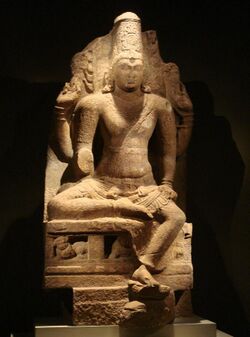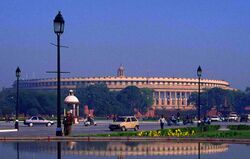Religion:Maha Upanishad
| Maha Upanishad | |
|---|---|
 The text discusses Narayana (Vishnu) | |
| Devanagari | महा |
| IAST | Mahā |
| Title means | Great[1] |
| Type | Vaishnava[1] |
| Linked Veda | Samaveda[2] |
| Chapters | 6 |
| Verses | 549[3] |
| Philosophy | Vaishnavism |
The Maha Upanishad (Sanskrit: महा उपनिषद्, IAST: Mahā Upaniṣad) is a Sanskrit text and is one of the minor Upanishads of Hinduism.[4][5] The text is classified as a Samanya Upanishad.
The text exists in two versions, one attached to the Atharvaveda in some anthologies,[6] and another attached to the Samaveda.[5] The Atharvaveda version is shorter, and in prose.[7][8] The Samaveda version is partly in poetic verses.[9]
The Vaishnava Upanishad describes Vishnu as the highest being, and above Brahma.[1] [10] Both groups of texts, however, use reverential words of all Hindu gods, and assert them to be the same Atman-Brahman.[10] The Upanishad presents a syncretism of Vaishnava and Vedanta ideas, and is notable for its teaching of "Vasudhaiva Kutumbakam", or "the world is one family".[11][12][13]
History
The date or author of Maha Upanishad is unknown, but Deussen considers it to be the most ancient of Vaishnava Upanishads attached to the Atharvaveda.[14]
Manuscripts of this text are also found titled as Mahopanishad.[9][15] In the Telugu language anthology of 108 Upanishads of the Muktika canon, narrated by Rama to Hanuman, it is listed at number 61.[16] In the collection of Upanishads under the title Oupanekhat, put together by Sultan Mohammed Dara Shikhoh in 1656, consisting of a Persian translation of 50 Upanishads and who prefaced it as the best book on religion, the Maha is listed at number 16.[17] Dara Shikoh's collection was in the same order as found in Upanishad anthologies popular in north India. In the 52 Upanishads version of Colebrook this Upanishad is listed at 9.[18] In the Bibliothica Indica edition of Narayana the Upanishad is also listed at 9 in his list of 52 Upanishads popular in South India.[19]
Contents
The Upanishad presents Vishnu as the highest being, above Samkhya principles, above Shiva, and above Brahma.[1] This Upanishadic text competes with Shaiva Upanishads, such as the Atharvashikha Upanishad and Atharvashiras Upanishad, which asserts Shiva as higher than Vishnu and Brahma.[20] Both groups, however, use profusely reverential words in describing all three – Brahma, Vishnu and Shiva (or Maheshvara, Rudra), and identify them as manifestations of the same universal Atman-Brahman (ultimate reality).[10]
One is a relative, the other stranger,
say the small minded.
The entire world is a family,
live the magnanimous.
Be detached,
be magnanimous,
lift up your mind, enjoy
the fruit of Brahmanic freedom.
The text references and uses fragments of Vedic hymns, such as from Taittiriya Brahmana section 2.2 and Shatapatha Brahmana section 6.1, but reformulates them in the image of Vishnu.[1] He as Brahman is the origin of the universe, asserts the text, from whom arose Purusha, Atman and Prakriti (nature, substances, body) of Samkhya philosophy.[22] For the last two concepts, the Upanishad uses the term Tejas.[22] Thereafter, from Narayana, arose Shiva and Brahma, the Om, the cosmic chants and songs, the meters of literature, then the Vedas. The text shares some verses with another Vaishnava text – the Mahanarayana Upanishad, and a Shaiva Upanishad – the Atharvashiras.[22]
The longer version of the text, which is attached to Samaveda, includes the shorter version as first part and then presents more text. It goes on to describe the path to liberation and bliss as one of realizing one's soul, of Brahman as knowledge and Vishnu.[23][24]
A liberated person is Jivanmukta, states the text, and is characterized by one who is untouched whether joy or grief befalls him, doesn't get angry at anyone or anything, neither is mean to anyone nor fears anyone, is free from desire and non-desire, is introverted and likes his own company, is silent and without arrogance, acts without envy or agitation, is detached and functions without cravings, is quiet and calm, active and full in spirit.[25][24] He is self-restrained, driven by inquiry, in company of good people, studies the Shastras, asks, "Who am I? How did Samsara develop?"[26][27] The drink of immortality for him, states the Upanishad, is his delight in the Self (soul, Atman), experiencing the joy of his own inner awareness and nature.[28][27]

The Vishnu-focussed text is notable for describing Shiva as the trident holding one, states Deussen, who possesses beauty, truth, chastity, austerity, renunciation, intelligence and mastery.[30]
The Upanishad is oft-quoted ancient text for the credo, "Vasudhaiva Kutumbakam" (Sanskrit: वसुधैव कुटुम्बकम्), or "the world constitutes but one family".[11][12][31] This verse of Maha Upanishad is engraved in the entrance hall of the parliament of India.[29]
The text has been influential in the major Hindu literature that followed it. The popular Bhagavata Purana, composed sometime between 500 CE and 1000 CE, the most translated of the Purana genre of literature in Hinduism,[32] for example, calls the Vasudhaiva Kutumbakam adage of the Maha Upanishad, as the "loftiest Vedantic thought".[33] This adage, according to Chung Tan, influenced the Chinese culture and is an example of "dynamics of boundarylessness of a Himalaya Sphere phenomenon, viz. Chinese culture with Indian input".[34]
See also
References
- ↑ 1.0 1.1 1.2 1.3 1.4 Deussen 1997, p. 799.
- ↑ Tinoco 1996, p. 89.
- ↑ AG Krishna Warrier (1953), Maha Upanishad, Theosophical Society, Madras, Online
- ↑ Deussen 1997, pp. 557, 561–567.
- ↑ 5.0 5.1 Tinoco 1996, pp. 87–89.
- ↑ Deussen 1997, pp. 566–567.
- ↑ Deussen 1997, pp. 799–801.
- ↑ Max Muller, Alphabetisches Verzeichniss der Upanishads at Google Books, Zeitschrift der Deutschen Morgenländischen Gesellschaft: ZDMG, Volume 19, page 151
- ↑ 9.0 9.1 Hattangadi 2000.
- ↑ 10.0 10.1 10.2 Deussen 1997, pp. 779–782, 799–801.
- ↑ 11.0 11.1 11.2 Jeffrey Moses (2002), Oneness, Random House Publishing, ISBN:0-345457633, page 12
- ↑ 12.0 12.1 Robin Seelan (2015), Deconstructing Global Citizenship (Editors: Hassan Bashir and Phillips Gray), Routledge, ISBN:978-1498502580, page 143
- ↑ BP Singh and Dalai Lama XIV Bstan-ʼdzin-rgya-mtsho (2008), Bahudhā and the Post 9/11 World, Oxford University Press, ISBN:978-0195693553, page 51
- ↑ Deussen 1997, pp. 799 with footnotes.
- ↑ Vedic Literature, Volume 1, A Descriptive Catalogue of the Sanskrit Manuscripts, p. PA498, at Google Books, Government of Tamil Nadu, Madras, India, pages 291, 498–499
- ↑ Deussen 1997, pp. 556–557.
- ↑ Deussen 1997, pp. 558–59.
- ↑ Deussen 1997, p. 561.
- ↑ Deussen 1997, pp. 564–65.
- ↑ Deussen 1997, pp. 779, 799.
- ↑ Hattangadi 2000, p. षष्ठोऽध्यायः ७१- ७५, Quote: अयं बन्धुरयं नेति गणना लघुचेतसाम् । उदारचरितानां तु वसुधैव कुटुम्बकम् ॥ भावाभावविनिर्मुक्तं जरामरणवर्जितम् । प्रशान्तकलनारभ्यं नीरागं पदमाश्रय ॥ एषा ब्राह्मी स्थितिः स्वच्छा निष्कामा विगतामया । आदाय विहरन्नेवं सङ्कटेषु न मुह्यति ॥ (...).
- ↑ 22.0 22.1 22.2 Deussen 1997, pp. 799–781.
- ↑ AG Krishna Warrier (1953), Maha Upanishad, Theosophical Society, Madras, Online, Verse II.1–11
- ↑ 24.0 24.1 Hattangadi 2000, p. द्वितीयोऽध्यायः.
- ↑ AG Krishna Warrier (1953), Maha Upanishad, Theosophical Society, Madras, Online, Verse II.42–62
- ↑ AG Krishna Warrier (1953), Maha Upanishad, Theosophical Society, Madras, Online, Verse IV.1–24
- ↑ 27.0 27.1 Hattangadi 2000, p. चतुर्थोऽध्यायः.
- ↑ AG Krishna Warrier (1953), Maha Upanishad, Theosophical Society, Madras, Online, Verses IV.34–39
- ↑ 29.0 29.1 S Shah and V Ramamoorthy (2014), Soulful Corporations, Springer Science, ISBN:978-8132212744, page 449
- ↑ Deussen 1997, p. 780.
- ↑ AG Krishna Warrier (1953), Maha Upanishad, Theosophical Society, Madras, Online, Verse VI.71–72
- ↑ Sheridan 1986, pp. 1–16.
- ↑ Badlani 2008, p. 184.
- ↑ Tan 2015, p. 63.
Bibliography
- Badlani, Hiro G. (September 2008). Hinduism: Path of the Ancient Wisdom. iUniverse. ISBN 978-0-595-70183-4. https://books.google.com/books?id=VCdWXWk6nEcC.
- Deussen, Paul (1 January 1997). Sixty Upanishads of the Veda. Motilal Banarsidass Publishers. ISBN 978-81-208-1467-7. https://books.google.com/books?id=XYepeIGUY0gC&pg=PA665.
- Deussen, Paul (2010). The Philosophy of the Upanishads. Oxford University Press (Reprinted by Cosimo). ISBN 978-1-61640-239-6. https://books.google.com/books?id=k_Bea7AXHY4C&pg=PA26.
- Hattangadi, Sunder (2000). "महोपनिषत् (Maha Upanishad)" (in sa). http://sanskritdocuments.org/doc_upanishhat/maha.pdf.
- Sheridan, Daniel (1986). The Advaitic Theism of the Bhāgavata Purāṇa. Columbia: South Asia Books. ISBN 81-208-0179-2. https://books.google.com/books?id=qrtYYTjYFY8C.
- Tan, Chung (1 January 2015). Himalaya Calling. World Scientific. ISBN 978-1-938134-60-9. https://books.google.com/books?id=Gjm6CgAAQBAJ&pg=PA63.
- Tinoco, Carlos Alberto (1996). Upanishads. IBRASA. ISBN 978-85-348-0040-2. https://books.google.com/books?id=7xoNEM63hZEC&pg=PA89.


